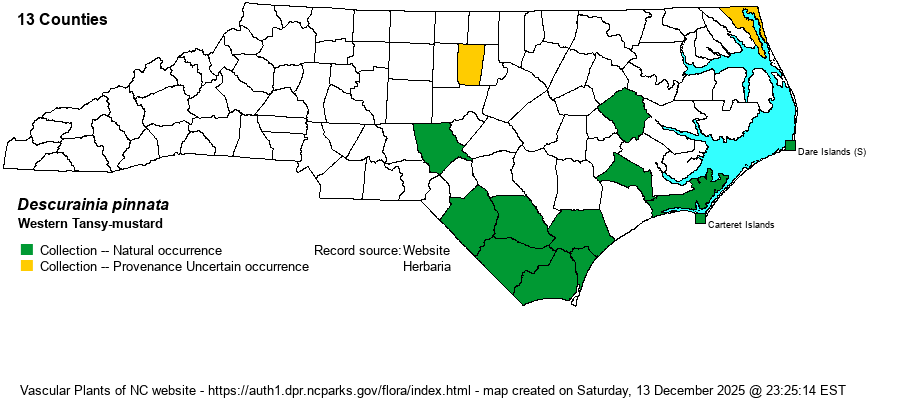| Author | (Walter) Britton | |
| Distribution | Scattered in the southern Coastal Plain, and barely into the northeastern portion (record for Currituck County) where apparently not native. A collection from Orange County, in the Piedmont, is treated here is perhaps non-native, and one wonders about the status of the species as a whole in the state, as this is a ruderal species. Weakley (2018) considers it as native to NC -- at least in the southern part of the Coastal Plain.
This is a very widespread Western species, with many records in FL, and scattered in most other Eastern states. Thus, where to draw the line between native and non-native range is fuzzy, but it appears probably native only north to southeastern NC. | |
| Abundance | Probably under-collected, as many biologists probably consider it of uncertain provenance, but seemingly rare to uncommon in the southern Coastal Plain, north to Moore and Pitt County. Most of the iNaturalist records are from the southeastern coast, in New Hanover and Brunswick counties. As the NCNHP considers it as not a native, but Weakley (2018) does, the website editors have selected a State Rank of S2S3 for the time being -- as it is a ruderal and under-collected species, though S2? may be better. | |
| Habitat | This is a species of sandy and disturbed ground in NC, such as sandy fields and sandy roadsides. It is not a plant of natural habitats such as pine/scrub oak sandhills or sand barrens. | |
| Phenology | Blooms from February to May, and fruits soon after flowering. | |
| Identification | This is an erect and very leafy herb, reaching about 1.5 feet tall; it often has several branches from the base, and the stems are very hairy. It has many alternate leaves, somewhat grayish-green, strongly pinnately dissected into 11 or more leaflets, and each leaflet is lobed, further dissected, etc., such that a single leaf is very finely cut; each leaf is oblong in shape and about 4 inches long and 1-inch wide on average. At the ends of upper branches are the racemes of flowers, each one being 4 inches long on average, with many small yellow flowers on long pedicels. Each of the 4 yellow petals is only about 1/8-inch long, and only a few are in bloom at a time. Still, you will note the bright yellow flowers at the top of a very leafy plant, with rather fern-like leaves. Note that an exotic -- D. sophia -- grows rarely in the Piedmont and Coastal Plain. That plant has long siliques that average 10-25 mm long, versus quite short ones of pinnata that are only 5-10 mm; thus, plants with fruit less than 2/5-inch long should be the "native" species. | |
| Taxonomic Comments | Weakley (2018) lists two varieties in NC, the native var. pinnata, and var. brachycarpa, not native to the state. The Currituck County collections apparently relate to this latter variety. Note that RAB (1968) considered this latter variety as a full species -- D. brachycarpa.
| |
| Other Common Name(s) | None | |
| State Rank | [S2S3] | |
| Global Rank | G5 | |
| State Status | | |
| US Status | | |
| USACE-agcp | | |
| USACE-emp | | |

